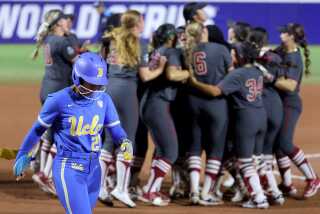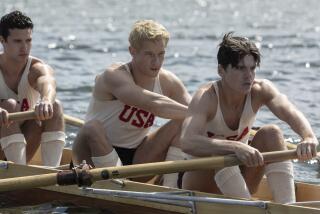It’s a Shell Game
- Share via
So you think you know pain?
Grab a pair of oars. Plop down in a shell -- a boat to you landlubbers -- and drive the 12-foot-long paddles at the rate of 35 to 45 rows per minute through a lake or river over courses as long as four miles.
Shoulders scream. Legs and arms knot up in cramps. Breathing is a chore.
So you think you know sacrifice?
Try training that includes hours of early-morning workouts in bone-chilling water and afternoons spent lifting weights, paddling land-rowing machines, running and performing other aerobic conditioning.
So what’s the incentive?
For Anne Molholm and Sarah Pomeroy, two senior rowers at USC, it’s the joy of competition and a sense of accomplishment.
The scholarships don’t hurt either.
“You either fall in love with it or you realize it’s not for you,” said Pomeroy, 21. “But if it’s something you love, you don’t think of all the sacrifices you do for the sport. You just go out there every day on the water.”
Adds Molholm, 22: “Once you cross the finish line, that is the reward. You have the satisfaction of giving your all or getting so amped up you want to do it again. I find rowing therapeutic.”
Today, on the 17th Girls and Women in Sport Day, Molholm and Pomeroy are among a growing number of female college athletes who are competing in sports other than basketball, swimming, and track and field.
Since 1972, when Congress enacted Title IX, prohibiting discrimination against girls and women in federally funded education, participation by women in college sports has soared.
According to the National Women’s Law Center, fewer than 32,000 women competed in intercollegiate athletics in 1972. By 2002, that number had increased nearly fivefold.
Anita DeFrantz, who won a bronze medal in rowing in the 1976 Olympics, loves to quote another statistic.
“Internationally, 74% of the elite rowers have university degrees, and 64% of them have advanced degrees,” said DeFrantz, who is president of the Amateur Athletic Foundation in Los Angeles. “So the sport requires a great deal of discipline, and an understanding you are part of the team. People in that environment tend to excel.”
Molholm, from Dublin, Ohio, and Pomeroy, who was born in Berkeley but reared in Simsbury, Conn., came to the sport in different ways
Pomeroy took up rowing in high school -- in part because her older sister rowed, and also because she was no longer interested in competitive swimming.
“We lived on a river, and it’s just a different part of our town,” Pomeroy said. “It was something a lot of children of my parents’ friends had done, and my sister’s age friends had done. So I developed an interest in it.”
Molholm, also a competitive swimmer, didn’t take up rowing until her freshman year in college.
“I had two older brothers who also swam go on to Marietta College [in Ohio] and join the crew,” she said. “My mom would drag me down to watch their races. And when rowers are doing it well, it looks effortless. It is very rhythmic. It can be mesmerizing, watching eight bodies work together.”
Both rowed at William Smith College in Geneva, N.Y., and could have spent the rest of their college careers in that Division III program. But in 2002 their coaches, Zenon and Kelly Babraj, announced they were taking jobs at USC.
“The new coach came from Kansas State, and I rowed with her in the fall,” Molholm said. “But it is hard to transfer coaches; all have different ideas. I missed Kelly. I’d speak with her in the fall and also with Sarah. I came here out in the spring of 2003.”
Pomeroy, who came to USC in 2002, said, “We all knew ... that Southern California must be a special place for them to want to leave. I just caught the bug with them. I always say it was more inconvenient for me to stay at my school and learn from a new coach than to rearrange my life and come out here with Zen and Kelly.”
USC offers 20 scholarships for its women’s team, although there are as many as 60 rowers in the program.
At present, 150 colleges and universities have teams. The NCAA started awarding a team championship in 1997. In 2002 a championship was awarded in divisions beyond Division I.
“It is a remarkable sport,” DeFrantz said. “I call it the ultimate team sport. You have to be in complete unison. And to power through the water; when you get it together, the boat flies. When you don’t, it’s an even longer race.”
Molholm and Pomeroy, good friends and economics majors, probably would have succeeded no matter what life direction they decided to follow.
But rowing has had an effect they could not have expected.
“I’ve learned a lot of life lessons,” Pomeroy said. “I feel like I have really grown up these past four years, and I really wouldn’t have done nearly as much without my teammates and coaches. It’s a great way to go through college, having something to focus your energy on. You feel that worthwhile feeling every day.”


